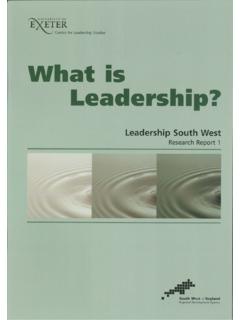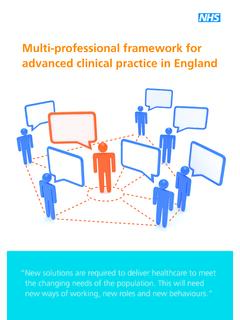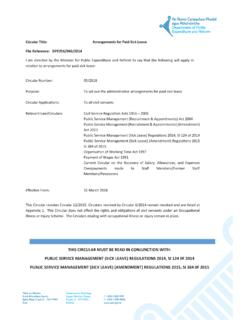Transcription of Leadership, Management and Organisational Development
1 - 1 - leadership , Management and Organisational Development Richard Bolden, Centre for leadership Studies, University of Exeter, UK In Gold, J., Thorpe, R and Mumford, A. (eds) (2010) Handbook of leadership and Management Development . Aldershot: Gower. Introduction In this chapter I suggest that leadership , Management and Organisational Development are all parts of the same process - namely enhancing the capacity of organisations, and the people within them to better achieve their purpose. As such, they are closely tied to strategic mission and all the systems that support it, as the Center for Creative leadership Handbook for leadership Development concludes: ''To be fully effective, a Development system must be integrated with the organization s other processes: Management planning, performance Management , job selection, reward and recognition systems, and even mistake systems.
2 The confluence of these processes determines the relative effectiveness of any one Development activity. 1 Despite the interdependence of these systems, however, they are often treated in relative isolation as a series of discrete initiatives outsourced to different parts of the organisation (Human Resources (HR), Finance, Information and Communications Technology (ICT), etc.) and consequently it is not surprising that many fail to deliver on their promise. Furthermore, leadership and Management Development (LMD) activities are often commissioned with little consideration of the underlying theories and assumptions on which they are based. Without an informed appreciation of the logic on which such initiatives are founded, however, and the proposed mechanism(s) by which they may lead to improved capacity and, in turn, enhanced performance it is unlikely that the desired outcomes will be achieved - to use the analogy you reap what you sow !
3 I begin this chapter by reviewing recent trends in LMD, before outlining the conceptual underpinnings of the most common approaches and exploring the relationship of LMD to other Organisational Development activities. The chapter concludes with a framework that can be used when considering which approach(es) to utilise, along with a number of recommendations on choosing a provider. Current trends in leadership and Management Development Management and executive education is big business, with an estimated $50 billion spent per year on leadership Development alone2. In a 2003 survey the Financial Times found leading European companies to be spending on average 3,336 per participant per year on executive education; 42% of respondents had a Corporate University (with a further 12% looking to establish one over the next couple of years); and of the topics offered leadership , followed by general Management , were the most popular3.
4 Within Higher Education (HE) provision, there are now 117 members of the Association of Business Schools in the UK (up from just two in the whole country in the mid-1960s) and in the years between 1996/7 and 2006/7 the number of students of Business and Administrative studies rose by 40% (from 222,321 to 310,255) with the greatest rate of change for post-graduate students (up by 66%), especially those on business and Management programmes such as the MBA4. Such trends are typical of the expanding global market for LMD - driven, in part, by the desire of educational providers to enter into what is seen to be a lucrative market and fuelled by political and corporate assertions about the value of effective leadership and the need to address a leadership and Management skills gap.
5 From an employer perspective the primary triggers for investing in LMD are considered to be the rapidly changing nature of the external environment, closely followed by business needs and HR strategy, and students are increasingly regarding leadership and Management related programmes as enhancing their employability and career prospects. - 2 -Despite an explosion in the provision of and demand for LMD, however, the link to improved performance remains inconclusive. Empirical research has remained unable to produce consistent evidence of either the relationship or the mechanisms by which it might occur. There are many reasons why this might be, including variations in the quality of provision, variable levels of integration with Organisational processes, personal and contextual differences in the most appropriate forms of Development and, even the possibility that such relationships are tenuous or inexistent.
6 Whatever the cause, however, organisations are well advised to consider when and how to invest in LMD after all, whilst it may be concluded that there is strong statistical evidence that Management Development leads to superior performance across companies of all sizes, sectors and national location [..] an impressive 16 percent of variance is explained by three factors: the extent to which HR is integrated with business strategy, the degree to which the firm takes a thoughtful, long-term approach to developing managerial capability and the belief by line managers that their employer is taking Management Development seriously 5 - in effect, factors outside the classroom. Increasing dissatisfaction with traditional approaches to LMD, along with an expanded marketplace, changing business challenges and advances in leadership theory, Development and practice have led to a diversification in the range of programmes and initiatives on offer.
7 In particular there has been increasing demand for postgraduate and short course or executive education within university provision; greater modularisation, flexibility and work-based learning from all providers; and more informal and personalised Development (such as mentoring, coaching, 360o feedback, project assignments, action learning sets and team facilitation) - see Table 1. Key Trends From To Type of provision Prescribed course Standardized Theoretical/academic Intervention/ Development programme Customized Applied/based on real-life challenges Time-frame One-off Discrete start & end points Continual An ongoing Development journey Format Didactic: lectures & presentations Abstract/conceptual Participatory: interactive activities & group work Experiential/reflective Location Classroom-based Off-site Blended (variety of methods) Work-based as well as off-site Focus Development of individuals Generic Development of individuals & groups Vocational/for a specific purpose Role of provider Supplier Expert Partner, collaborator & coach Co-designer/facilitator Nature of support Limited Primarily concerned with accreditation Theoretical/academic Extensive relationship Management Primarily concerned with client experience Coaching/mentoring Table 1 Changing trends in leadership development6 Such trends pose major practical and developmental challenges to providers of LMD.
8 Firstly, alongside the modularisation of formal programmes into bite size chunks there is increasing pressure to provide holistic programmes applicable to leaders and managers at all levels of the organisation. Secondly, the increase in personalised learning and customization of programmes poses serious resourcing challenges through the increased time required for developing and supporting provision and the high level of practical expertise required by staff. And thirdly, with the shift away from traditional career structures and employment arrangements managers are increasingly expected to determine and address their own Development needs rather than being directed to provision via their employer (hence increasing the need for promotion and legitimisation of Development activities)7.
9 Given the difficulty in implementing the changes highlighted above it is perhaps not surprising, therefore, that most HE provision remains in a traditional face-to-face, classroom mode and that where approaches such as e-learning are utilised this tends to be to support rather than replace traditional education ( via a blended approach). Furthermore, whilst employers clearly place great value on work-based learning much of this remains ad-hoc rather than via formalised job rotation, placements, exchanges and assignments. - 3 -Whilst much leadership Development remains focussed on the acquisition of knowledge and skills, however, it is proposed that one of the main benefits for practicing managers is the opportunity for reflection. For managers in fast-paced and demanding jobs, leadership Development can offer a protected space in which they can take time to slow-down and reflect on past, current and future events a period of calm in which they can regroup and reenergise for the challenges ahead - although, as John Storey argues, there may well be insufficient time allocated to this.
10 There is a fundamental dilemma that haunts many leadership Development events. Because leadership is perceived as fundamentally about doing rather than knowing , there is an inherent bias towards activity-focussed and indeed briskly paced encounters [..] In consequence, there is little time for reflection or strategic thinking. These characteristics of leadership Development events are self-evidently in tension with the kind of clear thinking supposedly required of top leaders. 8 The key to successful leadership Development , it would appear, is achieving an appropriate balance between knowledge-exchange, action and reflection, and alignment between the needs and wants of the individual and those of the organisation.











